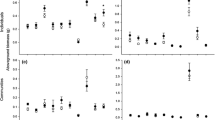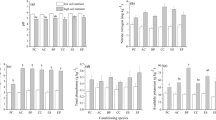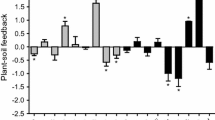Abstract
Understanding how competition from invasive species and soil conditions individually and interactively affect native performance will increase knowledge of invasion dynamics and can be used to improve the success of restoration plans. This study, conducted in Reno NV, USA, uses a two-phase plant–soil feedback experiment coupled with a target-neighbor competition design to examine the individual and interactive effects of both soil conditions and invasive neighbors on native performance. Study species include invasive species (Bromus tectorum and Agropyron cristatum) and native species (Elymus elymoides and Pseudoroegneria spicata). Results indicate that both plant performance and competitive interactions were influenced by species-specific soil conditioning. Specifically, invasive B. tectorum generated a larger competitive effect on natives than invasive A. cristatum; however, only A. cristatum conditioned soil in a manner that increased competitive effects of conspecifics on natives. Native P. spicata was relatively unaffected by soil conditioning and conversely, E. elymoides was strongly affected by soil conditioning. Few previous studies have examined soil conditioning and the interaction of soil conditioning and neighbor effects that both are potentially important mechanisms in structuring plant communities and influencing plant invasion.




Similar content being viewed by others
References
Armas C, Ordiales R, Pugnaire FI (2004) Measuring plant interactions: a new comparative index. Ecology 85:2682–2686
Bever JD (2003) Soil community feedback and the coexistence of competitors: conceptual frameworks and empirical tests. New Phytol 157:465–473
Bever JD, Dickie IA, Facelli E, Facelli JM, Klironomos J, Moora M, Rillig MC, Stock WD, Tibbett M, Zobel M (2010) Rooting theories of plant community ecology in microbial interactions. Trends Ecol Evol 25:468–478
Blank RR (2010) Intraspecific and interspecific pair-wise seedling competition between exotic annual grasses and native perennials: plant–soil relationships. Plant Soil 326:331–343
Cox RD, Allen EB (2011) The roles of exotic grasses and forbs when restoring native species to highly invaded southern California annual grassland. Plant Ecol 212:1699–1707
Davies KW, Sheley RL (2011) Promoting native vegetation and diversity in exotic annual grass infestations. Restor Ecol 19:159–165
Dijkstra FA, Hobbie SE, Reich PB (2006) Soil processes affected by sixteen grassland species grown under different environmental conditions. Soil Sci Soc Am J 70:770–777
Eliason SA, Allen EB (1997) Exotic grass competition in suppressing native shrubland re-establishment. Restor Ecol 5:245–255
Elton C (1958) The ecology of invasions by animals and plants. University of Chicago Press, USA
Eviner VT, Hawkes CV (2008) Embracing variability in the application of plant–soil interactions to the restoration of communities and ecosystems. Restor Ecol 16:713–729
Fansler VA, Mangold JM ( 2011) Restoring native plants to crested wheatgrass stands. Restor Ecol 19:16–23
Farrer EC, Goldberg DE (2009) Litter drives ecosystem and plant community changes in cattail invasion. Ecol Appl 19:398–412
Farrer EC, Goldberg DE (2011) Patterns and mechanisms of conspecific and heterospecific interactions in a dry perennial grassland. J Ecol 99:265–276
Freckleton RP, Watkinson AR (2000) On detecting and measuring competition in spatially structured plant communities. Ecol Lett 3:423–432
Grice T (2009) Principles of containment and control of invasive species. Invasive species management: a handbook of principles and techniques. Oxford University Press Inc, New York, pp 61–76
Grman E, Suding KN (2010) Within-year soil legacies contribute to strong priority effects of exotics on native California grassland communities. Restor Ecol 18:664–670
Gunnell KL, Monaco TA, Call CA, Ransom CV (2010) Seedling interference and niche differentiation between crested wheatgrass and contrasting native great basin species. Rangel Ecol Manag 63:443–449
Humphrey LD, Schupp EW (2004) Competition as a barrier to establishment of a native perennial grass (Elymus elymoides) in alien annual grass (Bromus tectorum) communities. J Arid Environ 58:405–422
Jordan NR, Larson DL, Huerd SC (2008) Soil modification by invasive plants: effects on native and invasive species of mixed-grass prairies. Biol Invasions 10:177–190
Kardol P, Wardle DA (2010) How understanding aboveground-belowground linkages can assist restoration ecology. Trends Ecol Evol 25:670–679
Klironomos JN (2002) Feedback with soil biota contributes to plant rarity and invasiveness in communities. Nature 417:67–70
Kulmatiski A, Beard KH, Stevens JR, Cobbold SM (2008) Plant–soil feedbacks: a meta-analytical review. Ecol Lett 11:980–992
Kulmatiski A, Heavilin J, Beard KH (2011) Testing predictions of a three-species plant–soil feedback model. J Ecol 99:542–550
Leger EA, Espeland EK (2010) The shifting balance of facilitation and competition affects the outcome of intra- and interspecific interactions over the life history of California grassland annuals. Plant Ecol 208:333–345
Meisner A, de Boer W, Verhoeven KJF, Boschker HTS, van der Putten WH (2011) Comparison of nutrient acquisition in exotic plant species and congeneric natives. J Ecol 99:1308–1315
Perkins LB, Nowak RS (2012) Native and non-native grasses generate common types of plant–soil feedbacks by altering soil nutrients and microbial communities. Oikos. doi:10.1111/j.1600-0706.2012.20592.x
Perkins LB, Johnson DW, Nowak RS (2011a) Plant-induced changes in soil nutrient dynamics by native and invasive grass species. Plant Soil 345:365–374
Perkins LB, Leger EA, Nowak RS (2011b) Invasion triangle: an organizational framework for species invasion. Ecol Evol 4:610–625
Richardson DM, Pysek P, Rejmanek M, Barbour MG, Panetta FD, West CJ (2000) Naturalization and invasion of alien plants: concepts and definitions. Divers Distrib 6:93–107
van de Voorde TFJ, van der Putten WH, Bezemer TM (2011) Intra- and interspecific plant–soil interactions, soil legacies and priority effects during old-field succession. J Ecol 99:945–953
van der Putten WH, Vandijk C, Peters BAM (1993) Plant-specific soil-borne diseases contribute to succession in foredune vegetation. Nature 362:53–56
van Grunsven RHA, van der Putten WH, Bezemer TM, Tamis WLM, Berendse F, Veenendaal EM (2007) Reduced plant–soil feedback of plant species expanding their range as compared to natives. J Ecol 95:1050–1057
Vila M, Weiner J (2004) Are invasive plant species better competitors than native plant species? Evidence from pair-wise experiments. Oikos 105:229–238
Wainwright CE, Wolkovich EM, Cleland EE (2012) Seasonal priority effects: implications for invasion and restoration in a semi-arid system. J Appl Ecol 49:234–241
Wardle DA, Bardgett RD, Klironomos JN, Setala H, van der Putten WH, Wall DH (2004) Ecological linkages between aboveground and belowground biota. Science 304:1629–1633
Acknowledgments
This research was supported by the Nevada Agricultural Experiment Station. This manuscript was improved greatly by comments, advice, and feedback provided by anonymous reviewers and Scot Ferguson.
Author information
Authors and Affiliations
Corresponding author
Rights and permissions
About this article
Cite this article
Perkins, L.B., Nowak, R.S. Soil conditioning and plant–soil feedbacks affect competitive relationships between native and invasive grasses. Plant Ecol 213, 1337–1344 (2012). https://doi.org/10.1007/s11258-012-0092-7
Received:
Accepted:
Published:
Issue Date:
DOI: https://doi.org/10.1007/s11258-012-0092-7




